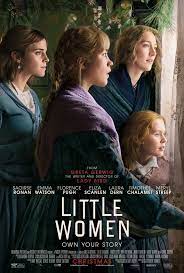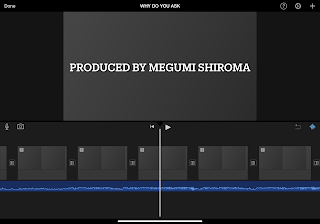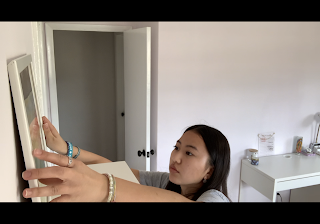Genre Research: Little Women
Common CAMS in the movie
Common camera angles in the film are eye level, high angle and low angle. An example of an eye level camera angle would be when Jo and Laurie are speaking to each other on the couch in the attic of the house. A high angle and low angle would be when there is a flashback to when Amy cuts her hand and stumbles upon Laurie’s house, where she yells and cries and Laurie and his tutor look down upon her.
Common camera movements in the film are pan, tracking shot and zoom. We see the tracking shot multiple times throughout the film, notably when Jo sells her first story at the publishing office and when Amy in the carriage, and Laurie, walking on the side of the road, see each other for the first time since they were kids.
Common shots in the film are the establishing shot, wide shot, long shot, medium long shot, medium shot, medium close up, two-shot, three-shot, POV shot and over the shoulder shot. An example of the establishing shot was Jo in front of the publishing office, about to walk in. An example of the two-shot is when Jo and Fredrich are together near the fireplace, talking.
Common CLAMPS in the movie
The costumes are based on the time period of the movie, which is set in the early 1860’s. These were Victorian-era clothing, meaning that women would wear bloomers or a chemise, a corset, a hoop and skirt, a petit coat and a skirt. However, not every March sister chooses to follow this clothing style that was expected of them. All the clothing styles reflect each character, their personality and their beliefs about society and themselves. Seeing that the March family were seen as “radicals” because their family did not always conform to society’s standards, their clothing styles were perhaps the most telling of this. For example, Jo wore lots of dark brown, dark blue and red. She wore lots of jackets, waistcoats and skirts that were made to look like trousers. She, however, would never go to the lengths of wearing trousers, because she is a girl (wearing trousers were for men only). She would instead, swap clothing with Laurie, a boy, rather than her sisters. This was a visual representation of how much Jo wanted to be a boy. To Jo, being a boy represented free will, power and control over her life and freedom. She wore lots of androgynous-looking clothes, but leaning toward masculine-like clothing, rather than feminine-like clothing, like corsets. On the other hand, her sisters Amy and Meg were quite the opposite. Meg and Amy-Amy being the sister most interested in fashion-always wore feminine-like clothing. Meg later on decides to start wearing the full set of the clothing that was expected of women at the time because she wants to be a “proper lady” once she is married. Meg dresses in an overly feminine way in order to conform to society’s standards whereas Amy dresses in a very feminine way because she genuinely likes to. Since she was a child, she loved fancy clothes and dressing up every chance she got. She would wear layers of hoops, skirts, coats, decorative hats and beautiful jewelry, a much vamped up version of her aunt. Beth is similar to Jo, except she never felt the need to dress in an overly feminine or masculine way. She wore mostly pink and brown and never dressed up for any occasion, because she never felt the need to. She stayed home her entire life, which was reflected into her clothing. She stayed a child, never truly growing up, even when she was an adult. The costumes are one of the most important elements of the movie. Alongside the acting of the characters, the costumes are what truly express how and what the character is about.
The lighting is one of a warmer color palette. Director Greta Gerwig decided to use warmer, natural lighting compared to the other films in her own remake because of how it would better represent the warmth and safety the sisters’ childhoods. A big component of the story of Little Women is how the sisters’ lives have changed since they have grown up. The color palette of the lighting from their childhood is one with very warm colors, lots of yellow, orange and brighter colors of their clothing. However, as the girls progress through their lives and transition from childhood to adulthood, the lighting changes to a more bleak and darker color palette. We see a lot more gray colors with pale lights, signifying how the girls have grown up and are no longer as safe and fun as they used to be when they were kids.
The acting in this film truly expresses the characters to where the audience are indulged in the complexities of the characters and truly understand why and how each character acts the way they do, as well as how they grow from childhood to adulthood. Each actress uses the perfect movements, gestures and dialogue in order to most accurately express each character. Each of the sisters, they each have their own separate personalities but do have certain characteristics that bring them all together. For example, Jo wants to be a boy in order to have the freedom and equal opportunities she so desperately longs for. She also wants to be loved, because she has been taught by society that love is all a woman is fit for (cue to her “But I am so lonely” scene, shortly after Beth’s death). Meanwhile, Meg has found love, she is married. However, she is unhappy in her marriage and unhappy in her current friendships because she has pretended to be someone she is not for so long. She has conformed to be so similar to her upper class friends, while she and her husband are struggling to make ends meet in their middle class life. Amy, however, feels that she is being forced to marry because she alone cannot support herself and her family. Due to women not being able to have jobs that paid enough to be financially stable, she feels that chasing her passion, art, specifically painting, is fruitless because she could never make enough money from her art nor could she be renowned for it. She feels hopeless and feels like she has to give up her dreams in exchange for financial stability for herself and her family. On the other hand, Beth feels distant from her sisters. This is due to the fact that they all have such robust personalities, and are very individual but yet similar. She is the exception as she is very quiet and keeps to herself.
The makeup in the film is very simple and conservative. Other than a little powder and blush, there is nothing more. The makeup looks from this era is rather simple and I believe the director and head of makeup decided it would be best to keep things historically accurate as much as possible.
The props in the film are historically accurate as possible, including carriages, street vendors and signs, telegrams and letters, lamps and vases. Two notable props are Amy’s paintings, Beth’s piano, Meg’s silk cloth and Jo’s notebook and final book at the end of the film.
As mentioned beforehand, the settings of the movie have also changed, from childhood to adulthood. The environments that the girls most frequently visited were of course the family home, the beach, Laurie’s grandfather’s house and fields of greenery. There is a definite difference to when the girls have grown up to when they are all grown up. The sets are now full of people, bustling environments where the girls now seem small and not important. The sets also now have less color, as well as the buildings and other locations now seem more industrialized and bleak.
The common sound in the movie are diegetic sound, sound bridge, soundtrack, incidental music, ambient sound and dialogue. Examples of the dialogue would be the conversations that characters have with each other, such as when Jo is speaking to Mr. Dashwood about buying her short story. The soundtrack was specially produced by Alexandre Desplat, with scores that matched perfectly with the scenes it accompanied.
Common editing in the film included fading in, fading out, reverse shot, eye-line match and jump cut. The reverse shot is utilized throughout the film, one example would be when Beth and Jo are at the beach having a conservation where Beth is trying to convince Jo to write again by asking Jo to write her a story. An example of the jump cut would be when the sisters all come back to the family home when they learn that Beth has fallen ill.
This film utilized the mood, atmosphere, dramatic tension and character relationships elements of drama throughout the entire film.
What elements of the genre did the movie have that you like?
I enjoyed the dramatic tension, character relationships and atmosphere elements of the film. It really added to the depth and complexity the movie had to offer, as well as developed the storylines and message of the film immensely.
What elements of the genre did the movie have that do not appeal to you?
The romantic tropes did not interest me, I feel as though it wasn’t truly necessary for some characters, although it was a huge component in the film. The sisters, all except Beth, did have troubles in their love life in one way or another. I just personally did not enjoy it.




Comments
Post a Comment